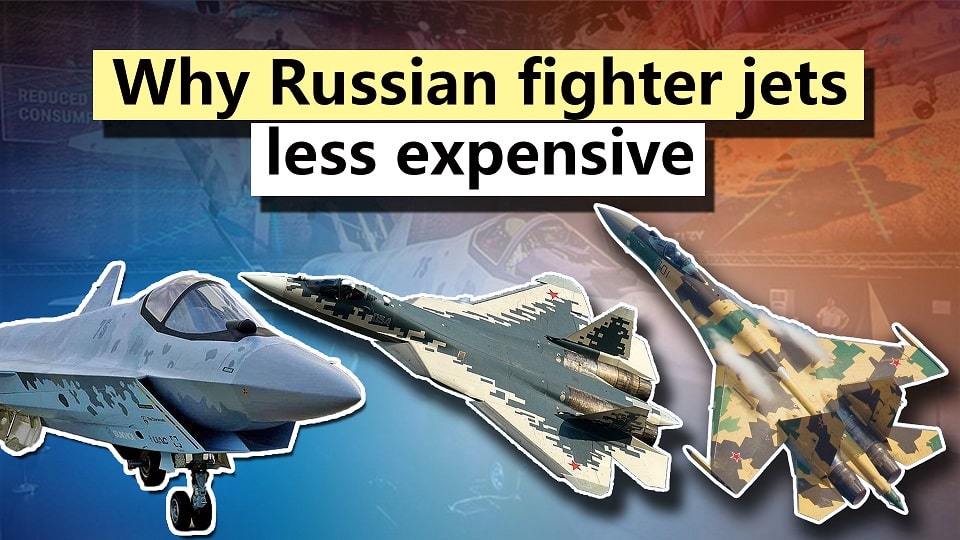Aerospace
Why are Russian fighter jets ten times cheaper than American fighter jets?

The cost disparity between Russian and American fighter jets is an intricate topic influenced by various factors. While the claim that Russian fighter jets are ten times cheaper than American ones is not entirely accurate, there are indeed significant differences in pricing between the two nations’ aircraft.
In this article, we will delve into the key reasons behind this cost disparity, taking into account factors such as technology, production methods, procurement processes, and the overall strategic objectives of each country’s military. By examining these factors, we can gain a better understanding of why Russian fighter jets are often more affordable than American ones and the implications this has on the global defense industry.
Labor Costs: One significant factor contributing to the cost disparity between Russian and American fighter jets is the difference in labor costs between the two countries. Labor costs in Russia are generally lower than in the United States. This can affect the overall cost of manufacturing military equipment, including fighter jets.
Currency Exchange Rates: Another factor that can impact the perceived cost of Russian fighter jets is currency exchange rates. Fluctuations in exchange rates between the Russian ruble and the U.S. dollar can play a significant role in determining the affordability of Russian military exports for foreign buyers.
Technology and Features: American fighter jets often incorporate more advanced technology and features, which can drive up their cost significantly. These technologies can include advanced radar systems, stealth capabilities, and more sophisticated avionics.
Manufacturing Infrastructure and Quality: The Western military-industrial complex benefits from decades of investment in advanced manufacturing infrastructure and quality control mechanisms. This infrastructure enables economies of scale, efficient production processes, and consistent high-quality output. On the other hand, the Russian military-industrial complex may not be as technologically advanced or efficient in its manufacturing processes, potentially resulting in lower production costs.
Russian Economic Factors: The overall health of the Russian economy is a critical determinant of the pricing of Russian fighter jets. Economic conditions, including currency exchange rates, and inflation, can influence the affordability and competitiveness of Russian military exports.
A robust Russian economy could provide the necessary resources to improve manufacturing infrastructure and invest in technological advancements. However, economic challenges may limit the government’s ability to increase subsidies or support the growth of its defense industry. Many improvements in Russian aircraft manufacturing, such as those seen in Sukhoi and to a lesser extent Mikoyan (MiG), have largely been self-funded by these companies.
while Russian fighter jets may sometimes appear significantly cheaper than American counterparts, this pricing discrepancy arises from a combination of factors, including technological disparities, market dynamics, manufacturing infrastructure, and economic conditions. The pursuit of excellence and the incorporation of cutting-edge technology in Western fighter jets contribute to their higher costs, while market forces and varying levels of technological advancement play a role in the perceived affordability of Russian fighter jets.

Aerospace
Boeing Transfers Rocket Stage to NASA, Paving Way for Human Moon Mission

Boeing has achieved a significant milestone by providing NASA with the second core stage of the Space Launch System (SLS) rocket.
This crucial component, crafted at NASA’s Michoud Assembly Facility (MAF), is set to propel the Artemis II crew into lunar orbit, marking humanity’s return to deep space after a 50-year hiatus.
The monumental Boeing-built rocket stage, the largest element of the Artemis II mission, will embark on a journey aboard the Pegasus barge, traveling 900 miles to NASA’s Kennedy Space Center.
Comparison of two legendary aircraft B777x vs B747 aircraft:Click here
Upon arrival, it will be meticulously integrated with other essential Artemis II components, including the upper stage, solid rocket boosters, and NASA’s Orion spacecraft within the iconic Vehicle Assembly Building. This intricate integration process is a vital step toward the eagerly anticipated Artemis II launch, slated for 2025.
“Boeing-built products helped land humankind on the moon in 1969, and we’re proud to continue that legacy through the Artemis generation,” remarked Dave Dutcher, vice president and program manager for Boeing’s SLS program. “Together, with NASA and our industry partners and suppliers, we are building the world’s most capable rocket and paving the way to deep space through America’s rocket factory in New Orleans.”
NASA, Lockheed Martin Reveal X-59 Quiet Supersonic Aircraft:Click here
The delivery of Core Stage 2 marks a significant achievement in the evolution of the SLS rocket. Towering over 200 feet and powered by four RS-25 engines, this core stage, coupled with two solid-fueled booster rockets, will generate a staggering 8.8 million pounds of thrust. This immense power is crucial to launching Artemis II and future missions into the vast expanse of space.
The SLS rocket stands unparalleled in its capability to transport both crew and substantial cargo to the moon and beyond in a single launch. Its extraordinary capacity will facilitate the delivery of human-rated spacecraft, habitats, and scientific missions to destinations including the moon and Mars, ushering in a new era of space exploration.
-

 Travel1 week ago
Travel1 week agoAir India to Expand US Operations with Three New Routes After a Decade
-

 Travel2 weeks ago
Travel2 weeks agoWhy We Should Avoid These Stamps in a Passport
-

 Airlines1 month ago
Airlines1 month agoInvestigations Reveal Fake Chinese Titanium in Boeing and Airbus Jets
-

 Tech4 weeks ago
Tech4 weeks agoChina’s CATL Plans 1,800-Mile Electric Plane Launch by 2027
-

 Airport3 days ago
Airport3 days agoTop 10 Largest Airports in the World by Size
-

 Aerospace4 weeks ago
Aerospace4 weeks agoChina’s Fighter Jets Turn Wings into Autonomous Drones
-

 Airlines4 days ago
Airlines4 days agoAir India Rolls Out A350s for Delhi-New York JFK and Newark Routes
-

 Defence3 weeks ago
Defence3 weeks agoBoeing Enhances Chinook with New Engines and Block II Upgrades at $96 Million







